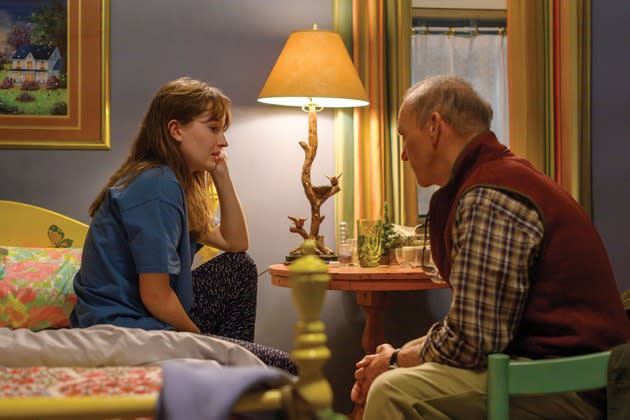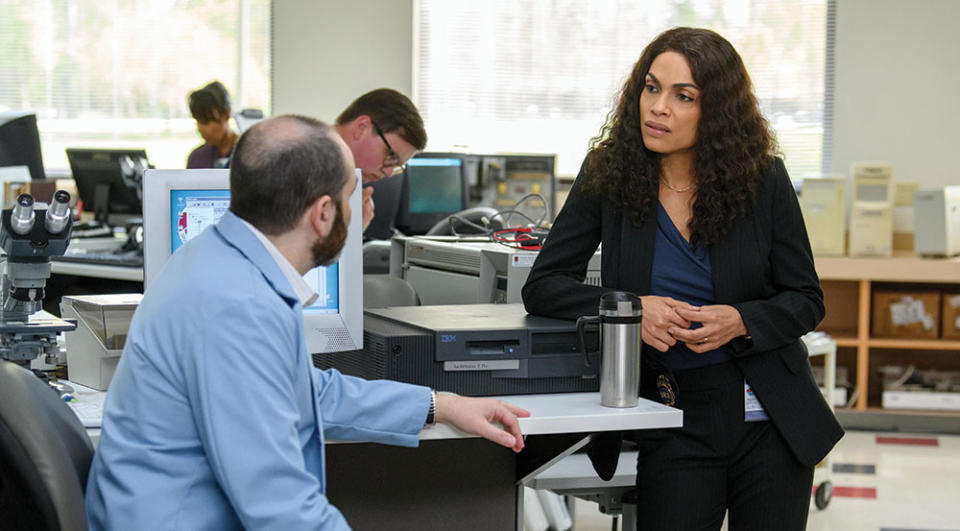‘Dopesick’ Writer-Director Danny Strong Says the Show Was “a Collective Mission” to Honor Purdue Pharma’s Victims
- Oops!Something went wrong.Please try again later.
- Oops!Something went wrong.Please try again later.
- Oops!Something went wrong.Please try again later.

Actor-writer-director Danny Strong is no stranger to celebrating on Emmys night. He earned two Emmys in 2012 for writing and producing HBO’s political drama Game Change, which followed his Emmy-nominated screenplay for the similarly ripped-from-the-headlines HBO film Recount in 2008. Since that double win a decade ago, Strong has gone on to co-create the Fox drama series Empire with Lee Daniels (who also directed The Butler from a script by Strong).
Strong is a multiple nominee again this year for Hulu’s limited series Dopesick, for which he earned nods for writing and directing in addition to outstanding limited series. Dopesick follows the rise of the opioid crisis in the United States and the nefarious actions of Purdue Pharma, which developed and aggressively marketed OxyContin while hiding its highly addictive properties. The result is a multi-layered true crime saga that traces the Sackler family-controlled Purdue’s shady business practices, the government officials who tried to curtail the distribution and use of the drug, and the victims of deceptive marketing whose lives spun out of control once they were addicted to OxyContin.
More from The Hollywood Reporter
'The White Lotus' EP David Bernad Teases Season Two: "You Will Have No Idea Where the Show Is Going"
'Pam and Tommy' Showrunners on Why Lily James Was the "Perfect" Casting to Play Pamela Anderson
Strong spoke to THR about the challenges and benefits of fictionalizing true events and how Dopesick was a cathartic experience for many of the cast and crew who worked on the project.
How did you develop the show, and when did Beth Macy’s book Dopesick come into play?
I had done a ton of research, conceived and sold the show before I even knew the book Dopesick existed. I sold it to 20th Century Studios, and before we took it to networks, Fox 21, the sister studio, bought the book in a bidding war. I quickly raised the flag, and they asked me if I would take a look at the book, and perhaps even team up with them on their project. I read the book, and I loved it. I thought it was a beautiful book, incredibly well done. And then I met with Beth Macy and [producer] Warren Littlefield. Beth was amazing. She really wanted to be a big part of the project, and I thought, “To have an expert in the writers room, how could that be a bad thing?”
The Sacklers were still a part of lawsuits while you were creating, and shooting, the show. What were the challenges to working on something based on a story that was ongoing?
I always knew that the spine of the story was the origin story of the opioid crisis, and that it would end with the 2007 sentencing hearing of the Purdue Pharma executives. That would be our journey: 1996 to 2007. It was pretty contained in that way.
The show depicts characters in the throes of addiction. Were there specific things you wanted to show for the audience to understand, and were there any tropes you hoped to avoid?
I wanted it to feel as real as possible. That was a guiding tonal concept through the whole production: We’re doing a true story. It’s a devastating story. It’s a crime story. And it needs to feel as truthful and as real as possible. It wasn’t something I had a strong firsthand knowledge of. I had preconceived notions of it, I think similar to many people’s preconceived notions — which is that the person who’s addicted, it’s their fault. It’s their weakness. It’s their laziness. It’s their desire to be more interested in drugs and alcohol than in the responsibilities of life. When I started researching it, [I learned about] opioid use disorder. [The drug] hijacks your brain, and you feel as if you’re going to die if you don’t get it. That condition is called “being dopesick.” It blew my mind that everything that I thought of as addiction was wrong. That was another guiding force behind the portrayal of addiction in the show.
That was also Purdue Pharma’s explanation for the crisis: It was the user’s fault for abusing the drug — nothing to do with how addictive the drug really was.
It’s the very core of how this [crisis] went on for many years. Purdue was able to convince authorities in the government that their drug was safe, that their victims were the ones that were responsible for the abuse. Richard Sackler said, “We have to hammer the abusers. They are the culprits. They are the villains.” I was so taken by that quote that I named one of the episodes after it. That’s exactly what Purdue did when in fact, Purdue was the abuser. They are the villains. They are the culprits. And they blame their victims for their crimes.
Many actors on the show have said in interviews that nearly every member of the cast and crew had been touched by the opioid crisis in some way. I imagine there were a lot of people who could bring a sense of accuracy to the show.
We had someone in the props department who had a lot of firsthand experience and knowledge that he was so honest about. He was able to make the [drug] paraphernalia look extremely real. And it was so important to me that it all looked real, that it wasn’t glamorized or [what] some people call “opioid porn,” where you see photographs of people [who look] like they’re wallowing in the darkness. I wasn’t interested in any of that. He was an incredible asset. We shot the show in Virginia, and there were so many people [on set] who have lost family members, friends, years of their own lives to drugs. There was the sense of a collective mission that everyone was on in telling the story.
I knew that we were doing something really powerful when, in the first week of shooting, we had a scene where the U.S. attorneys were just discussing OxyContin — there was nothing emotional in the scene whatsoever. After we did a few takes, I saw someone in the crew in the corner crying. It was just hearing the drugs discussed that made this person cry. I thought, “Wow, I’m so glad we’re not only telling this story, but we’re telling it here in Virginia, where it all happened” — so there could maybe be something cathartic for the people on the crew who experienced this, too, to be part of telling that story.

The show has characters who are based on real people, such as the Sacklers, and then fictional characters, like Michael Keaton’s Dr. Finnix and Kaitlyn Dever’s Betsy. Was it a challenge to write those composite characters, and to also capture the essence of your real characters?
I really love working in this way, in which you have true stories intertwined with composite characters. It’s an effective way to work. The last time I did that was with The Butler — [Forest Whitaker’s Cecil Gaines, based on White House butler Eugene Allen] was a composite character, as were his family members. They intersected with historical characters and events that were all true, but the personal dynamics were fictionalized. That gives you the best of history to work with and the latitude to dramatize and make up your own storyline. In this case, I loved going back and forth. The challenge was that each episode had three timelines, and [I had to figure out] how to make them dramatically compelling and not confusing. The hardest part of the show was pulling that off. I thought that was the best way to make it a hopefully riveting piece of entertainment and something that was propulsive — this intense crime story with the tragedy of the victims and the villainy of the actions of Purdue Pharma.
As someone who was an actor before you ventured into writing and directing, did your experience in front of the camera guide your role behind it?
My background as an actor is my biggest asset as a writer-director. I was a stage actor before I was doing television; I was working on Shakespeare and Chekhov and Ibsen, Edward Albee and Arthur Miller — all these incredible writers. I was fortunate enough when I started booking television shows that I was on Buffy the Vampire Slayer and Gilmore Girls. [That] set a bar in my head of what great writing is. When I write, I’m playing the scenes as I’m writing — I’m acting them out myself. When I block a scene before the actors are there, I block it out as if I’m an actor, and then I bring the actors in and let them follow their instincts. This is very organic process. I feel like I’m as actor-friendly a director as you’re going to find, because I view myself as one of them. I just want them to feel comfortable and have a good time, because I think that’s where the best work comes from.
Interview edited for length and clarity.
This story first appeared in an August stand-alone issue of The Hollywood Reporter magazine.
Best of The Hollywood Reporter

